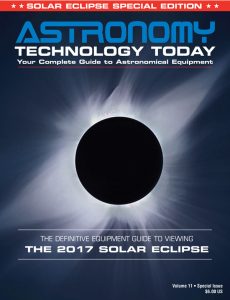While Tele Vue may be best known for creating state-of-the-art eyepieces and high-end telescopes, the company also offers a number accessories for observing and imaging. Recent additions to the company’s lineup include two types of Digiscoping adapters and Digital Indicator kits.

Digiscoping
Taking photos through a telescope eyepiece is an easy way to step into nature and planetary/solar photography. Tele Vue has two types of Digiscoping adapters: FoneMate, for smart phones (Image 1), and a Digital Rings/Radian Adapter system (Image 2), for point-and-shoot cameras with filter threads.
Tele Vue adapters allow solid, accurate attachment of smart phones and digital cameras to appropriate Tele Vue eyepieces for “afocal” imaging (Digiscoping). “Afocal” means collimating light between the telescope eyepiece and camera lens. To minimize vignetting and maximize image quality, Tele Vue offers an eyepiece specifications table for eyepieces recommended for Digiscoping. As noted in the table, some eyepieces require an additional adapter.

When imaging the 2017. Eclipse, these offers a great opportunity to utilize your smartphone or DSLR with a telescope that has been properly set up for Solar imaging.
Digital Indicator and TVFocus Software
Tele Vue’s Digital Indicators employ TVFocus software and a special RS232cable to monitor a telescope’s focus position on a Windows PC (Image 3). TVFocus features include: continuous or momentary position readout; up to four preset positions – saved between sessions (this feature is handy when swapping filters that change the point of best focus or when using non-parfocal eyepieces); yellow and green indicators when approaching or have achieved a preset focus position; and zero reset provides the ability to zero the indicator at any point.
You can learn more by visiting www.televue.com.
###
 The Astronomy Technology Today editorial staff would like to take this opportunity to remind you of the availability of our Solar eclipse equipment guide – The Definitive Equipment Guide to the 2017 Solar Eclipse. Our goal with the 40 page publication is to provide an easy-to-consume introduction to the technological options for viewing and imaging the Great Solar Eclipse. We cover the gamut of options available including building you own solar viewer, solar glasses, smart phones, DSLR cameras, using astronomy telescopes, solar telescopes, using binoculars, solar filters (including a DYI filter option), CCD astro cameras, astro video cameras, webcams and much more. You can view the guide on our website here – its free and there is no requirement to sign up to read the guide.
The Astronomy Technology Today editorial staff would like to take this opportunity to remind you of the availability of our Solar eclipse equipment guide – The Definitive Equipment Guide to the 2017 Solar Eclipse. Our goal with the 40 page publication is to provide an easy-to-consume introduction to the technological options for viewing and imaging the Great Solar Eclipse. We cover the gamut of options available including building you own solar viewer, solar glasses, smart phones, DSLR cameras, using astronomy telescopes, solar telescopes, using binoculars, solar filters (including a DYI filter option), CCD astro cameras, astro video cameras, webcams and much more. You can view the guide on our website here – its free and there is no requirement to sign up to read the guide.



